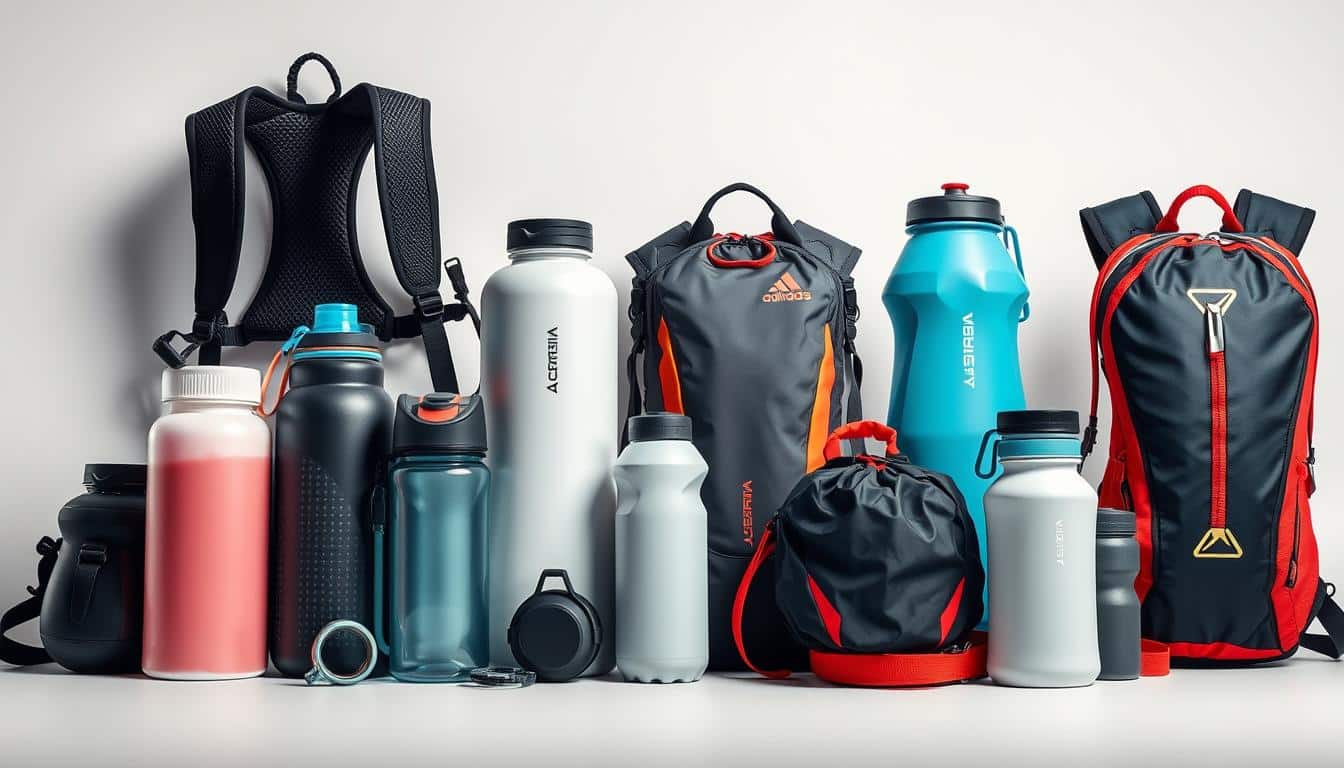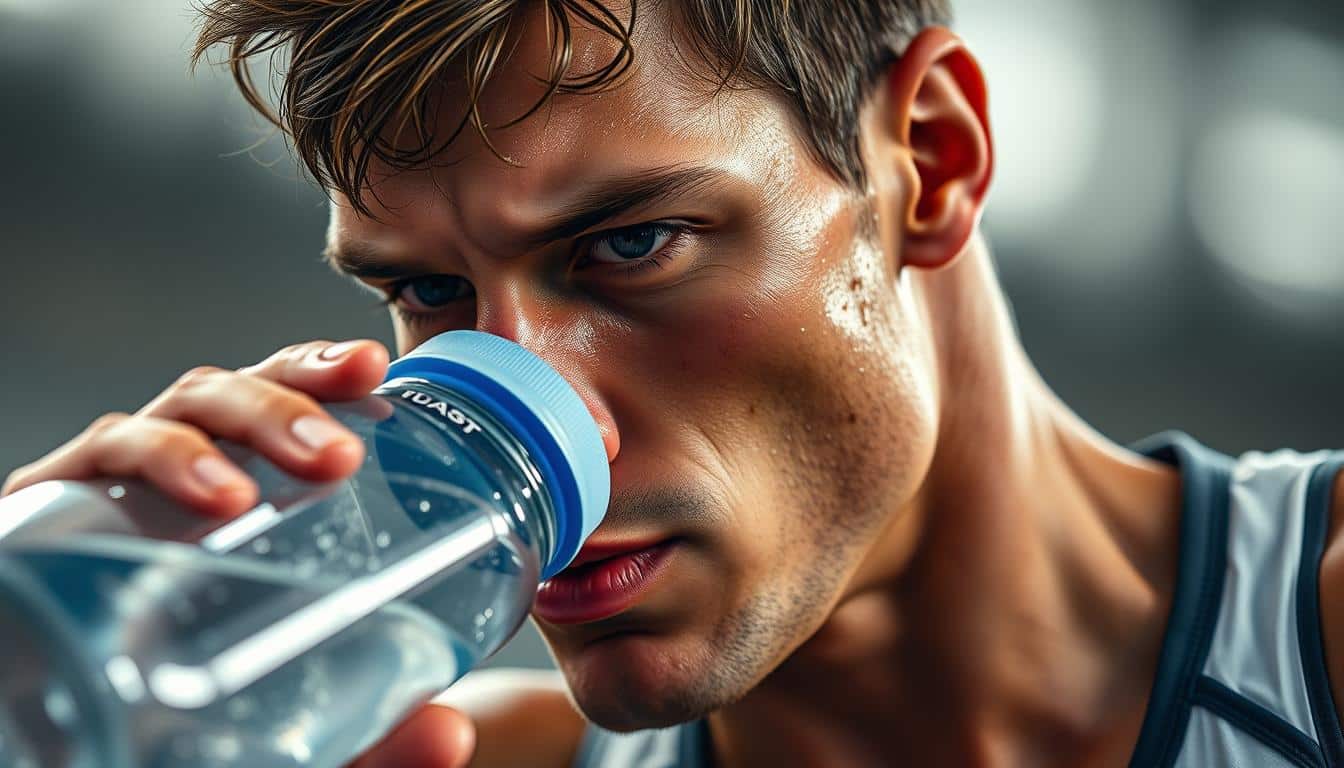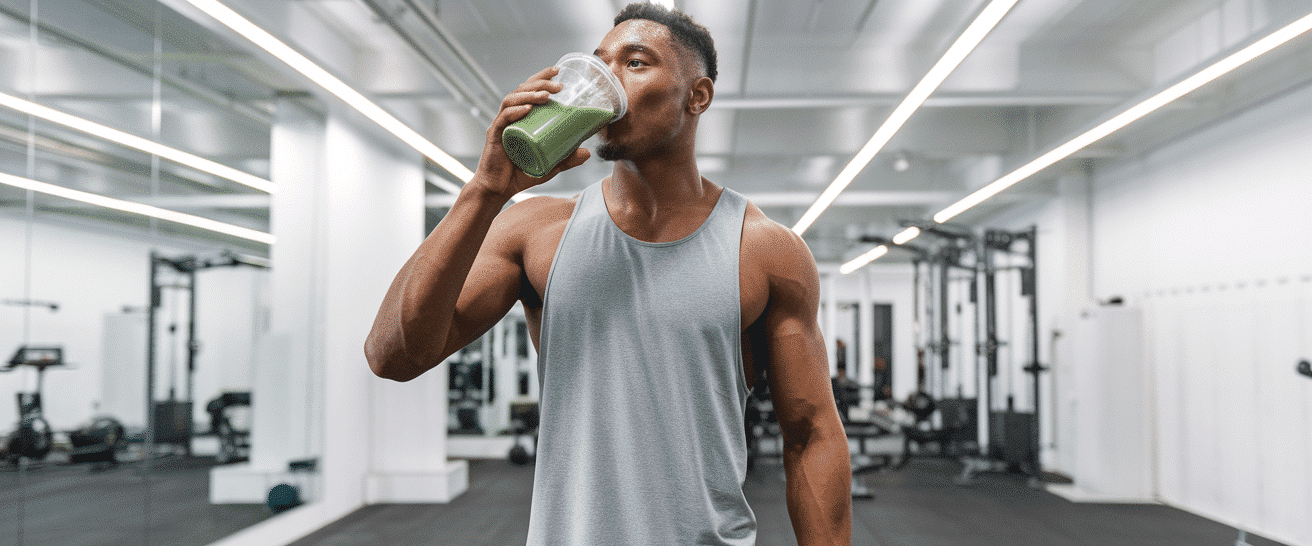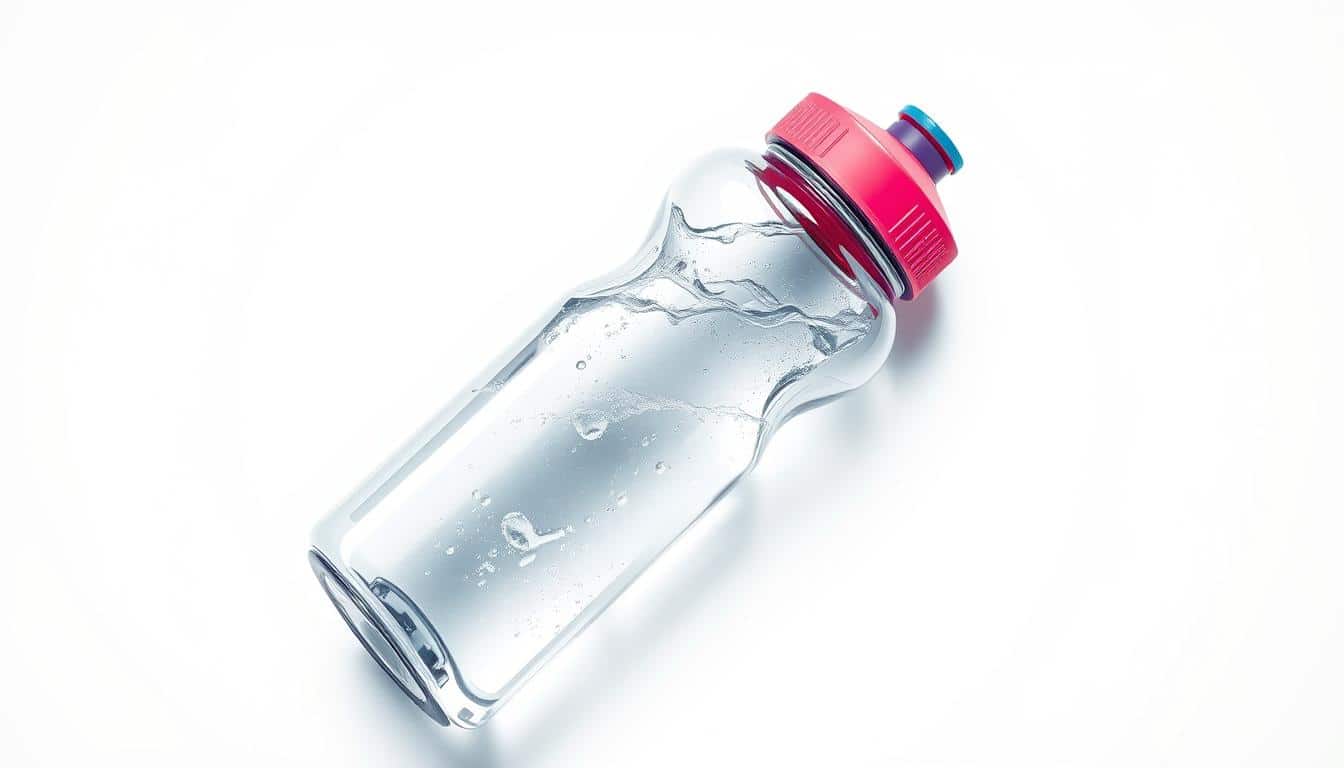Did you know 75% of active adults don’t drink enough during workouts? Exercise physiologist Chris Mohr, PhD, explains why this matters: your performance can drop by 25% with just 2% dehydration. Proper hydration isn’t just about comfort—it directly impacts muscle recovery, injury prevention, and stamina.
We’ve tested over 30 containers to find solutions that fit real training needs. Whether you’re lifting weights or running trails, your choice affects how often you sip and how easily you stay fueled. The right container becomes your workout partner—not an afterthought.
Look for features matching your routine. Marathoners need lightweight designs that won’t slosh, while gym enthusiasts might prioritize quick-access lids. Durability matters when you’re tossing gear into bags or dropping it between sets.
Our guide cuts through the clutter. You’ll discover which materials withstand extreme temps, which lids prevent leaks, and which sizes keep you sipping all day. No fluff—just practical insights to match your sweat sessions.
Introduction
Choosing the right hydration gear can make or break your training session. Different activities demand specific features—what works for weightlifting fails during trail runs or soccer matches. We tested containers in real-world conditions, from sweaty gym floors to muddy trails, with input from exercise specialists and coaches.

Here’s what matters most: ease of use mid-activity. Containers that leak or require two hands to open disrupt your flow. Our tests revealed three critical pain points athletes face:
- Intermittent access during high-intensity intervals
- Temperature control for outdoor sessions
- Durability against drops and impacts
| Activity | Top Priority | Feature Solution |
|---|---|---|
| Gym Sessions | Quick sip access | Flip-top lids |
| Long Runs | No-slosh design | Pressure valves |
| Team Sports | Crush resistance | Reinforced materials |
Your hydration tool shouldn’t compete with your focus. The right choice lets you drink instinctively—like grabbing a towel between sets. Next, we’ll explore how fluid intake directly impacts muscle recovery and endurance.
Why Hydration Matters for Athletes
Ever wonder why top performers prioritize hydration? Exercise scientist Chris Mohr, PhD, explains: your body loses 1-3 liters of fluid hourly during intense sessions. That’s not just sweat—it’s fuel your muscles and brain need to function.

Dehydration hits harder than you think. Lose just 2% of your body weight in fluids, and reaction times slow. Strength drops by 5-10%. Even mild dehydration makes workouts feel 20% tougher mentally. Thirst? It’s a lagging indicator—by the time you feel it, you’re already underperforming.
Here’s the kicker: your needs change daily. Heat, workout length, and genetics all affect how much you should drink. Mohr recommends starting with 17-24 oz of water 2 hours pre-session, then sipping 4-8 oz every 15-20 minutes. Think of it like fueling a car before a road trip.
- Pre-hydration boosts blood volume for better oxygen flow
- Mid-session sips maintain muscle lubrication
- Post-workout fluids aid recovery by flushing waste products
Want to level up? Pair your hydration routine with electrolyte-rich solutions during longer sessions. Your body isn’t just losing water—it’s shedding sodium and potassium critical for nerve function. Get this right, and you’ll outlast plateaus while reducing cramps and fatigue.
Key Features to Consider in Sports Water Bottles
What separates a good hydration container from a great one? It’s not just about holding liquid—it’s how the design adapts to your movement. The right combination of materials and functionality keeps you focused on your performance, not your gear.
Material & Insulation
Your container’s construction impacts every sip. Stainless steel options resist flavor transfer and maintain temperatures for 24+ hours—ideal for outdoor workouts. Plastic versions cut weight by 30-50%, perfect for runners needing quick access without arm fatigue.
Insulation matters most when temperatures climb. Double-walled designs prevent condensation while keeping drinks chilled through marathon sessions. Non-insulated materials work better for short indoor routines where frequent refills aren’t an issue.
Capacity & Portability
Match your container’s size to your activity’s demands. Compact 12-ounce models fit in bike holders, while 32-ounce versions suit weightlifters needing fewer breaks. Oversized jugs with measurement markers help track daily intake goals.
Look for grip-friendly textures and carabiner clips when choosing. A tapered profile slides into tight gym bag pockets, while wide mouths accommodate ice cubes easily. Your perfect balance of capacity and convenience depends on how you move.
Best Water Bottle for Athletes: A Closer Look
The right hydration gear feels like an extension of your workout routine. Three standout options prove how smart design solves common training frustrations.
Owala’s 30-ounce FreeSip Sway shines with dual access: sip from the straw during reps or tilt for a faster flow. Its lid locks securely but opens with a thumb press—no fumbling between sets. The tapered shape fits most cup holders, while the powder-coated finish resists gym bag scratches.
CamelBak’s 21-ounce Podium model caters to cyclists and runners. The squeeze-activated spout delivers precise sips without spills. A zippered pocket on the sleeve stores keys or energy gels. Bonus: its self-sealing valve prevents leaks when you toss it sideways.
- Nathan ExoDraw 2.0 collapses to 3 inches when empty
- Insulated sleeve keeps drinks cool for 4+ hours
- Dedicated pouch holds chews or electrolyte tabs
| Model | Capacity | Standout Feature |
|---|---|---|
| Owala FreeSip | 30 ounces | Dual straw/sip mechanism |
| CamelBak Podium | 21 ounces | Squeeze-to-spray nozzle |
| Nathan ExoDraw | 22 ounces | Foldable + storage compartment |
These options prioritize what athletes need mid-session. You’ll notice textured grips that stay secure in sweaty palms and lids that withstand repeated drops. Whether you’re hydrating during hill sprints or between bench presses, smart design keeps you focused on performance—not your gear.
Insulated vs. Non-Insulated Options
Ever opened your drink mid-workout to find it lukewarm? Temperature control separates premium hydration tools from basic ones. Let’s break down how insulation works and when it’s worth the investment.
Benefits of Insulation
Double-walled containers like the Yeti Rambler act like thermoses for your workouts. They keep water cold for 24+ hours—even in direct sunlight. This matters when you’re cycling through intervals or hiking steep trails. Sweat-drenched sessions feel bearable when every sip stays refreshing.
Insulated water bottles also prevent condensation. No more wet gym bags or slippery grips. The trade-off? They weigh 30% more than standard models. But for marathon training or outdoor yoga, that extra heft pays off in consistent hydration.
Drawbacks of Non-Insulated Bottles
Basic options like HydraPak’s $7 model shine in specific scenarios. They’re 40% lighter—ideal for speed drills or short weight room circuits. Without insulation, though, drinks warm up fast. You’ll need frequent refills during summer practices.
Non-insulated bottles work best when you’re near coolers or indoor fountains. Their slim profiles fit easily in treadmill cup holders. Just don’t expect them to maintain temperature through a 3-hour tennis match.
| Feature | Insulated | Non-Insulated |
|---|---|---|
| Temperature Control | 24+ hours cold | 2-3 hours max |
| Weight | 13-17 oz | 8-12 oz |
| Cost | $25-$45 | $7-$15 |
Your training environment decides the winner here. Hot climates and endurance sessions demand insulation. Quick gym visits? Save weight and cash with simpler bottles. Many athletes own both—using each where they excel.
Ergonomic and One-Handed Operation Designs
Ever struggled to open your drink while juggling groceries and a phone? Modern hydration tools solve this with thumb-activated lids and secure grip patterns. Your gear should adapt to life’s chaos—not add to it.
Push-button mechanisms rule here. The Owala FreeSip Sway opens with a single click, letting you sip without tilting your head. Cyclists love CamelBak’s magnetic caps that snap back into place mid-ride. No more lost lids or awkward fumbling.
Three features make or break one-handed use:
- Textured surfaces that grip even when sweaty
- Locks preventing accidental spills in bags
- Spouts aligning naturally with your mouth’s position
| Mechanism | Benefit | Ideal For |
|---|---|---|
| Flip-top caps | Instant access | Gym intervals |
| Magnetic closures | No lid flapping | Outdoor runs |
| Twist-lock spouts | Leakproof security | Travel/Tote bags |
Smart design considers how your hand moves during activity. Curved profiles nestle against palms during squats. Wider bases prevent tipping on uneven surfaces. When every second counts, your hydration gear shouldn’t slow you down.
Next time you shop, test the cap with your non-dominant hand. Can you operate it while holding a yoga mat? That’s the true test of ergonomic engineering.
Material Quality: Stainless Steel and BPA-Free Plastic
Your hydration gear’s material affects more than just durability—it shapes your entire training experience. Stainless steel options like Takeya and Yeti resist flavor absorption, making them ideal for protein shakes or electrolyte drinks. They handle drops better than plastic and maintain temperatures for hours, perfect for outdoor sessions.
BPA-free plastic containers from brands like HydraPak cut weight by 40%, a game-changer for runners. These materials cost less upfront but may retain odors if you use flavored supplements. They’re easier to replace if left at the track or gym.
Consider these factors when choosing:
- Steel containers last 5+ years with proper care
- Plastic models save 10-14 ounces in your gear bag
- Steel naturally resists bacteria buildup
- Plastic works better for short, intense workouts
| Feature | Stainless Steel | BPA-Free Plastic |
|---|---|---|
| Cost | $25-$50 | $8-$20 |
| Weight | 13-17 oz | 5-9 oz |
| Lifespan | 5+ years | 1-3 years |
Your training style decides the winner. Lifters and hikers benefit from steel’s ruggedness, while cyclists and HIIT enthusiasts gain from plastic’s lightweight design. Both materials keep you hydrated—just pick what matches your routine’s demands.
Hydration Solutions for Gym Workouts
Ever juggle weights while reaching for a drink? Fitness centers demand gear that adapts to tight spaces and fast-paced routines. The right hydration tools solve three gym-specific headaches: spill-proof storage, equipment compatibility, and quick access mid-set.
Look for containers that slide into treadmill cup holders. HydraPak’s 20-ounce model fits perfectly at 2.5 inches wide—and costs under $10. Rotate two or three for back-to-back sessions without washing hassles. Magnetic lids like CamelBak’s prevent flapping during deadlifts or box jumps.
These features matter most:
- 3-inch diameters fitting elliptical machine cages
- Textured grips that won’t slip from chalky hands
- Wide mouths for ice cubes and powder mixes
| Model | Capacity | Key Gym Feature |
|---|---|---|
| Takeya Sport | 24 oz | Leakproof twist cap |
| CamelBak Chute | 750 ml | Magnetic dust cover |
| HydraPak Stash | 20 oz | Treadmill holder fit |
Busy gym days require gear that survives crowded benches and accidental kicks. Choose materials like stainless steel or BPA-free plastic that withstand drops. Your drink stays secure between sets—no puddles on the weight bench.
Multiple Drinking Options and Versatile Lids
Your hydration needs shift faster than a HIIT routine. Modern lids adapt to these changes with multiple access points designed for real-world training. The Owala FreeSip demonstrates this perfectly—its integrated straw lets you sip during planks while the wide mouth handles post-sprint gulps.
Three key designs dominate the market:
- Twist-activated caps (BrüMate Era Tumbler)
- Push-button straw systems (Owala)
- Quick-release spouts (Yeti Rambler)
Straw-based lids shine during floor exercises. You can drink while maintaining plank form or bench pressing without tilting your head. Chug-friendly spouts work best between heavy sets when every second counts. The BrüMate’s leak-proof twist cap survives chaotic gym bag journeys—no more soaked protein bars.
| Lid Type | Best For | Example Model |
|---|---|---|
| Straw + Sip Combo | Multi-task hydration | Owala FreeSip |
| Twist Lock | Travel security | BrüMate Era |
| Wide Spout | Rapid rehydration | Yeti Rambler |
Smart engineering solves two problems at once. Magnetic closures prevent lost caps during trail runs. Textured surfaces maintain grip when your hands sweat through deadlifts. The right lid becomes invisible during workouts—you drink instinctively, without breaking focus.
Design and Size: Fitting Your Active Lifestyle
Finding your hydration sweet spot starts with matching container size to your movement patterns. A 12-ounce handheld model slips into running belts, while massive 128-ounce jugs fuel all-day adventures. Your activity’s duration and refill access dictate what works—you wouldn’t haul a gallon container through spin class.
Handheld options in the 12-16 ounce range keep runners light and agile. Mid-size picks (20-30 ounces) suit most gym sessions, balancing capacity with portability. Need all-day fuel? Oversized containers track intake without constant refills during hikes or tournaments.
Design details matter as much as volume. The Owala FreeSip Sway tapers at the base to grip car cup holders—no spills during commutes. CamelBak’s Podium model adds a phone pocket for trail runners needing essentials access. These thoughtful touches prevent gear from disrupting your flow.
Look for features like silicone handles that hook onto gym bags or bike frames. Wide-mouth openings simplify ice additions, while slim profiles slide into treadmill cages. Your perfect match blends smart engineering with real-world practicality, becoming an effortless part of your routine.


